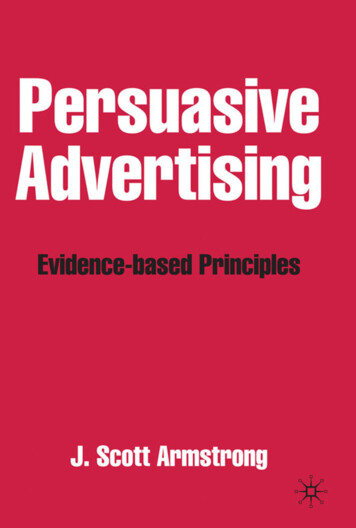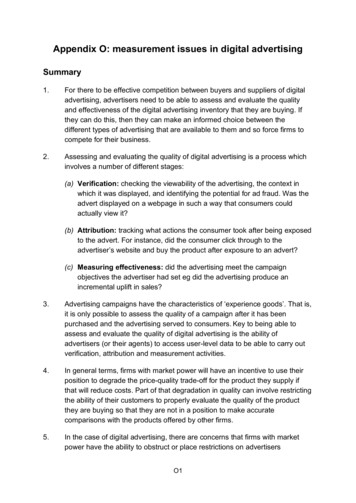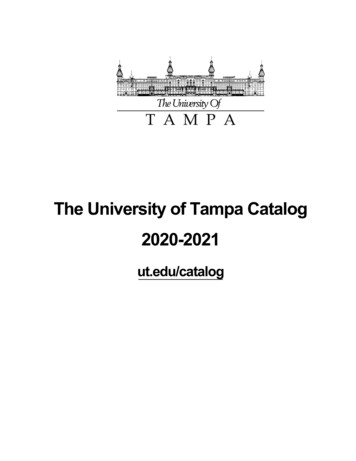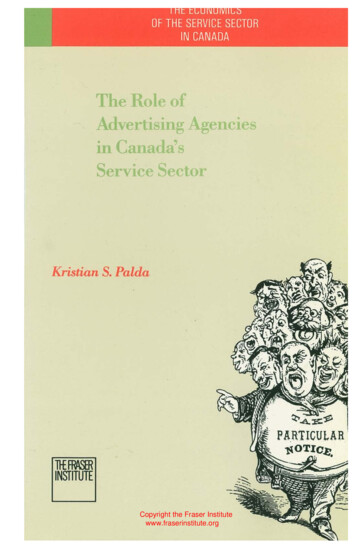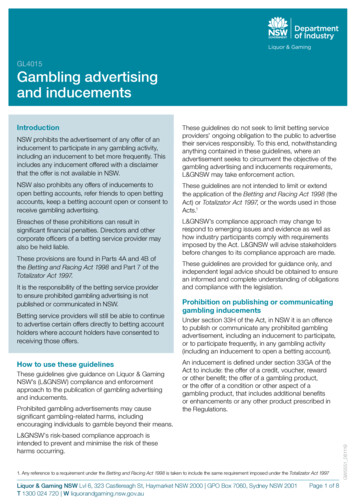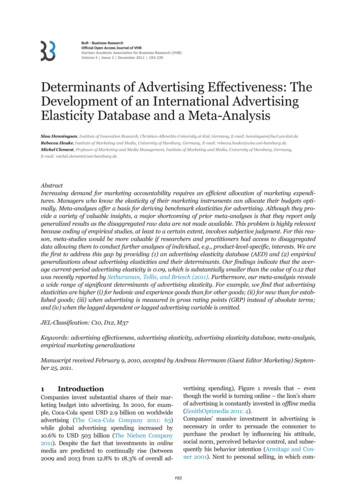
Transcription
BuR - Business ResearchOfficial Open Access Journal of VHBGerman Academic Association for Business Research (VHB)Volume 4 Issue 2 December 2011 193-239Determinants of Advertising Effectiveness: TheDevelopment of an International AdvertisingElasticity Database and a Meta-AnalysisSina Henningsen, Institute of Innovation Research, Christian-Albrechts-University at Kiel, Germany, E-mail: henningsen@bwl.uni-kiel.de.Rebecca Heuke, Institute of Marketing and Media, University of Hamburg, Germany, E-mail: rebecca.heuke@wiso.uni-hamburg.de.Michel Clement, Professor of Marketing and Media Management, Institute of Marketing and Media, University of Hamburg, Germany,E-mail: michel.clement@uni-hamburg.de.AbstractIncreasing demand for marketing accountability requires an efficient allocation of marketing expenditures. Managers who know the elasticity of their marketing instruments can allocate their budgets optimally. Meta-analyses offer a basis for deriving benchmark elasticities for advertising. Although they provide a variety of valuable insights, a major shortcoming of prior meta-analyses is that they report onlygeneralized results as the disaggregated raw data are not made available. This problem is highly relevantbecause coding of empirical studies, at least to a certain extent, involves subjective judgment. For this reason, meta-studies would be more valuable if researchers and practitioners had access to disaggregateddata allowing them to conduct further analyses of individual, e.g., product-level-specific, interests. We arethe first to address this gap by providing (1) an advertising elasticity database (AED) and (2) empiricalgeneralizations about advertising elasticities and their determinants. Our findings indicate that the average current-period advertising elasticity is 0.09, which is substantially smaller than the value 0f 0.12 thatwas recently reported by Sethuraman, Tellis, and Briesch (2011). Furthermore, our meta-analysis revealsa wide range of significant determinants of advertising elasticity. For example, we find that advertisingelasticities are higher (i) for hedonic and experience goods than for other goods; (ii) for new than for established goods; (iii) when advertising is measured in gross rating points (GRP) instead of absolute terms;and (iv) when the lagged dependent or lagged advertising variable is omitted.JEL-Classification: C10, D12, M37Keywords: advertising effectiveness, advertising elasticity, advertising elasticity database, meta-analysis,empirical marketing generalizationsManuscript received February 9, 2010, accepted by Andreas Herrmann (Guest Editor Marketing) September 25, 2011.1vertising spending), Figure 1 reveals that – eventhough the world is turning online – the lion’s shareof advertising is constantly invested in offline media(ZenithOptimedia 2011: 4).Companies’ massive investment in advertising isnecessary in order to persuade the consumer topurchase the product by influencing his attitude,social norm, perceived behavior control, and subsequently his behavior intention (Armitage and Conner 2001). Next to personal selling, in which com-IntroductionCompanies invest substantial shares of their marketing budget into advertising. In 2010, for example, Coca-Cola spent USD 2.9 billion on worldwideadvertising (The Coca-Cola Company 2011: 63)while global advertising spending increased by10.6% to USD 503 billion (The Nielsen Company2011). Despite the fact that investments in onlinemedia are predicted to continually rise (between2009 and 2013 from 12.8% to 18.3% of overall ad193
BuR - Business ResearchOfficial Open Access Journal of VHBGerman Academic Association for Business Research (VHB)Volume 4 Issue 2 December 2011 193-239With regard to advertising elasticities, Assmus, Farley, and Lehmann (1984) reported a mean shortterm advertising elasticity of 0.22. This finding wasrecently updated by Sethuraman, Tellis, and Briesch(2011), who reported an average current-periodadvertising elasticity of 0.12.What these meta-analyses of advertising and othermarketing elasticities have in common is that theyreport valuable generalized findings. Unfortunately,they do so at a highly aggregated level withoutproviding the database from which the results arederived. Thus, prior meta-analyses do not allowresearchers to (i) quickly determine which studiesreport elasticities on a specific topic; (ii) easily aggregate prior elasticity findings with respect to certain subgroups; or (iii) run their own, e.g., producttype-specific, analyses to optimize research-relatedand real-life marketing decisions.In summary, we address two major research gaps inthe field of advertising elasticities with this study:First, even though a few meta-analyses on advertising elasticities exist, the underlying data have neverbeen made available, thus preventing access to thedisaggregated data. Second, because the underlyingdatabase is unavailable, the findings of conventionalmeta-analyses cannot be retraced. This situation isunsatisfactory because coding involves personaljudgment, which may mean that the findings ofmeta-analyses need to be adjusted to specific contexts.In order to eliminate these shortcomings, this studycontributes to extant research by providing the firstinternational, online-access advertising elasticitydatabase (AED, Web Appendix 1), which includesempirical elasticities from the 62 studies outlined insection 3.1. For all of these studies, a large numberof characteristics are coded, including most of themoderator variables used by Sethuraman, Tellis,and Briesch (2011) as well as additional ones, suchas competitive effects, seasonality, income, andvarious publication details which are outlined insection 2. With respect to the type of advertisingelasticity, we have found 602 short- and 143 longterm elasticities in the empirical studies. Due to ourfocus on contemporaneous effects, we have calculated current-period elasticities, i.e., short-termelasticities derived from long-term elasticities,wherever possible. These calculations yielded anadditional 58 current-period elasticities. The AED isenhanced by a coding handbook (Web Appendix 2)and by a study overview, which contains a summarypanies in the US invest almost three times theamount spent on advertising (Albers, Mantrala, andSridhar 2010), advertising is the second largestinvestment to influence consumer behavior.Figure 1: Global Advertising Spending byMedium600Billion 7.6%200920102011Years20122013RadioCinema & Outdoor0NewspapersMagazinesTVInternetSource: ZenithOptimedia 2011 (estimated values for 2011-2013)Such high advertising expenditures have to be justified by satisfactory financial outcomes, so marketingmanagers are greatly interested in measuring theresponse to advertising expenditures (Lehmann2004; Srinivasan, Vanhuele, and Pauwels 2010).A powerful measure to quantify the effect of advertising is the advertising elasticity, which is dimensionless and simple to interpret (Parsons 1975; Tellis 1988). Albers, Mantrala, and Sridhar (2010: 840)defined the elasticity as “the ratio of the percentagechange in output (e.g., dollar or unit sales) to thecorresponding percentage change in the input (e.g.,dollar expenditures on advertising”. The particularadvantage of elasticities arises from the fact thatmanagers who know the elasticity of their marketing instruments are able to allocate their budgetsoptimally (Albers 2000). This ability requiresknowledge of advertising elasticities – ideally drawnfrom an easily accessible database.Despite the high relevance of marketing elasticitiesfor managerial decision making and marketing scientists, only a few meta-analyses have focused onthis topic. Albers, Mantrala, and Sridhar (2010)found a mean elasticity of 0.34 for personal selling.Bijmolt, Van Heerde, and Pieters (2005) report amean price elasticity of -2.62 which indicates a substantial increase over time compared to the meanprice elasticity of -1.76 reported by Tellis (1988).194
BuR - Business ResearchOfficial Open Access Journal of VHBGerman Academic Association for Business Research (VHB)Volume 4 Issue 2 December 2011 193-239of the characteristics of the included studies (Table 1in Section 3.1). Thus, our online AED (i) presents asimple but comprehensive overview of scientificresults, (ii) provides a maximum level of transparency, (iii) offers deep insights into the effectivenessof advertising activities at a disaggregated level,thereby allowing for benchmarking, and (iv) enablesresearchers and managers to conduct analyses tailored to their particular needs. Hence, this onlineAED will facilitate further research and help totransfer the results into management practice.With respect to the second research gap, we aim toquantitatively generalize empirical findings on thedeterminants of the relationship between advertising and the response to advertising. Thus, we conduct a meta-analysis to study whether, in what direction, and to what extent the potential determinants influence advertising effectiveness. Focusingon contemporaneous effects of advertising in themeta-analysis, original short-term elasticities areconsolidated with the current-period elasticitiesderived from long-term elasticities, before they areanalyzed jointly as a single category termed ”current-period elasticities”. While 602 short- and 143long-term elasticities are coded in the AED based on62 empirical studies and 60 different data sets, weinclude 659 current-period and 23 non-convertiblelong-run advertising elasticities in our metaanalysis. We find an average value of 0.09 for current-period elasticities. The advantage of this overprior meta-analyses is that our results can be understood perfectly, because every single coding decisioncan be retraced with the help of the coding description and the AED. The meta-findings can thus beeasily adjusted to particular needs.The remainder of this paper is organized as follows:The next section introduces the potential determinants of advertising elasticity. The coding of theAED as well as the derivation of hypotheses for potential determinants of advertising elasticity arepresented in section 3. Section 4 addresses the estimation of the hierarchical meta-analysis model andpresents the findings. Implications, limitations, anddirections for further research conclude this paper.2ing effect across a wide range of industries. Theselection of the moderating variables is based onextant theoretical and empirical research on advertising efficiency (e.g., Vakratsas and Ambler 1999).In addition, we consider prior findings on determinants of the elasticities of advertising (Assmus, Farley, and Lehmann 1984; Sethuraman, Tellis, andBriesch 2011) and other marketing mix instruments(e.g., Albers, Mantrala, and Sridhar 2010; Bijmolt,Van Heerde, and Pieters 2005; Kremer, Bijmolt,Leeflang, and Wieringa 2008). Finally, we includefurther variables derived from the coded studiesthat may influence advertising effectiveness. Figure2 depicts nine groups of determinants that are mostlikely to affect advertising elasticity.In the following, the relationships between themoderating variables and advertising elasticity arebriefly outlined for each of the nine groups of potential determinants: (1) Advertising medium: Priorliterature identifies substantial differences in advertising elasticity magnitudes according to the underlying advertising medium (e.g., Vakratsas and Ambler 1999). Thus, the advertising medium (such asTV, print, or direct mail) used to communicate theadvertising message is included in the AED.(2) Product determinants: First, theoretical rationale and empirical findings explain why advertising response varies for different product types. Forexample, entertainment products (such as movies)are hedonic-experience goods for which a qualityand value assessment prior to consumption is almost impossible (Sawhney and Eliashberg 1996).Thus, advertising plays a major role in reducinguncertainty for these products. Second, research hasshown that elasticities decrease during the product’slife cycle (Vakratsas and Ambler 1999). Finally,cultural differences combined with different advertising strategies (e.g., due to region-specific marketregulations) explain why advertising effectivenessdiffers with respect to the region in which the product is marketed (e.g., Elberse and Eliashberg 2003;Lambin 1976). (3) Data determinants: Followingearlier meta-analyses (e.g., Kremer, Bijmolt,Leeflang, and Wieringa 2008), we include a widerange of data determinants to control for datadriven effects such as the measurement of key variables (i.e., dependent and advertising variables) ordata aggregation levels and time frames. (4) Carryover effects: It is not unreasonable to assume thatmodels that account for carryover effects lead toPotential Determinants ofAdvertising ElasticityOur AED and the subsequent meta-analysis aim toinclude and analyze published and unpublishedempirical studies dealing with any sort of advertis-195
BuR - Business ResearchOfficial Open Access Journal of VHBGerman Academic Association for Business Research (VHB)Volume 4 Issue 2 December 2011 193-239Figure 2: Potential Determinants of Advertising Elasticity Magnitudesponse. For example, a time variable is often included in models to account for trends in the data, andcompetition variables are used to account for thedifferent strengths of market participants. (7) Interaction effects: Advertising elasticities are affectednot only by marketing and the aforementionedmarket-related determinants but also potentially byinteraction effects (e.g., Deighton, Henderson, andNeslin 1994). Therefore, we include these effects inour framework. (8) Estimation determinants: Inorder to capture effects on advertising elasticitiesthat can be attributed to the wide field of estimation,we include the functional form and the estimationmethod and account for endogeneity and heterogeneity in the AED. (9) Publication determinants:Finally, prior meta-analyses (e.g., Albers, Mantrala,and Sridhar 2010) reported publication-relatedbiases. Hence, the publication type (e.g., publishedversus unpublished) and whether the paper has aspecific focus on advertising effectiveness are listedin the AED. Furthermore, we control for potentialbiases that could arise from publication in market-lower elasticity magnitudes compared to those thatdo not account for such dynamics because in thelatter case, carryover effects might spuriously beattributed to current advertising (Albers, Mantrala,and Sridhar 2010; Farley and Lehmann 2001).Hence, we investigate the effect of the omission of(i) the lagged dependent variable and (ii) lagged orstock advertising variables. (5) Marketing determinants: This group mainly includes the typical marketing mix elements, such as price, quality, andpromotion. Because advertising campaigns oftenemploy several media at the same time (so-calledmulti-channel marketing), we code which furtheradvertising media (in addition to the one for whichthe elasticity is noted) are analyzed in the empiricalmodel of a study. The purpose is to be able to account for the fact that further advertising mediamight be partially responsible for sales response. (6)Market-related determinants: In addition to marketing-related effects, we include a set of marketrelated determinants that are well established in themarketing literature to influence advertising re196
BuR - Business ResearchOfficial Open Access Journal of VHBGerman Academic Association for Business Research (VHB)Volume 4 Issue 2 December 2011 193-239manual journal search of the leading internationaljournals in the field: International Journal of Research in Marketing, Journal of Marketing, Journal of Consumer Research, Journal of MarketingResearch, Management Science, Marketing Letters, Marketing Science, Journal of Business, andBuR – Business Research. Finally, we conducted across-reference search based on the papers found toidentify further relevant studies (including published books).Each study then had to meet a series of four criteriato be included in the AED: (i) We include only studies that analyze brand- or product-level advertisingeffects. Thus, studies dealing with industry-leveleffects are excluded. (ii) We include only studiesthat focus on direct-to-consumer advertising. Thus,papers dealing with business-to-business aspectsare excluded. (iii) We only include studies that havederived results based on empirical real-life sales orchoice data. Thus, results derived on the basis ofexperiments are excluded. (iv) We only includestudies that report (or allow us to derive) elasticitiesin the form of a percentage change in the responsevariable due to a one-percent change in the advertising variable (abbreviated in the following as %/%elasticities). Thus, in contrast to Sethuraman, Tellis,and Briesch (2011), we exclude studies using othertypes of elasticities (e.g., semi-elasticities, Goeree2008).Table 1 provides an overview of the studies that areincluded in the AED and the subsequent metaregression. It contains 62 studies that were published between 1962 and 2010 and whose 60 datasets cover the time span from 1869 to 2005 acrossa wide range of industries, product types, advertising media, continents, and modeling approaches.The studies were published as articles in internationally recognized journals or conference proceedings, as books, or are not yet published. Thus, wereduce potential influences due to publication bias(Cooper 1989).Compared to the meta-analysis of Sethuraman,Tellis and Briesch (2011), we exclude two studies(Chintagunta, Kadiyali, and Vilcassim 2006; Goeree2008) because %/% elasticities could not be calculated for these studies due to a lack of information.We include an additional book by Frank and Massy(1967) and papers from Ainslie, Drèze, and Zufryden (2005); Arora (1979); Elberse and Eliashberg(2003); Erdem, Keane, and Sun (2008); Montgom-ing-related versus non-marketing-related outlets orhigh- versus low-ranked journals.In summary, the conceptual framework and theAED do not include two variables employed by Sethuraman, Tellis, and Briesch (2011). These arerecession and product-type services which are excluded due to lack of information, an excessivelyhigh requirement of coding judgment, or our slightly different product sub-groupings. Variables thatare additionally (or at a more disaggregated level)included in this study are: product-type entertainment media, region- (mostly continent-) specificinformation, internal or external data source, reference frame, number of periods, spatial dimension,personal selling, additional advertising media used,seasonality, income, production costs, industrysales, competitive effects, number of further variables (including a brief description), and three publication details, namely the marketing orientation ofthe publication outlet, the publication outlet’s ranking, and a study’s focus on an advertising-effectiveness topic. The complete range of variables coded inthe AED serves as the basis for the subsequent meta-analysis, which as a result, uses some differentexplanatory variables to prior meta-studies (differences will be outlined in section 4.4). The next section describes the search procedure for the includedempirical studies and the coding of variables.3Advertising Elasticity Database(AED)3.1 Identification of StudiesThe research base of the AED is generated by a multiple literature search approach to ensure that allpublished and unpublished studies that either report advertising elasticities or, in case elasticities areunavailable, provide sufficient information to calculate them, are included.Our starting point was the list of studies included inthe two prior meta-analyses on advertising elasticities (Assmus, Farley and Lehmann 1984; Sethuraman, Tellis, and Briesch 2011). Next, we systematically searched for studies using major computerized databases for bibliographic data (e.g.,ABI/Inform, Business Source Premier by EBSCO,Science Direct) and enriched the findings by conference proceedings and relevant working papers published online (e.g., SSRN). Third, we conducted a197
BuR - Business ResearchOfficial Open Access Journal of VHBGerman Academic Association for Business Research (VHB)Volume 4 Issue 2 December 2011 193-2393.2.1 Coding of the dependent variable “advertising elasticity” (AED columns N-AC)The coding of the advertising elasticity serves twopurposes: (1) setting up a comprehensive, openaccess database of advertising elasticities that can beused for any scientific or managerial aim and (2)enabling a meta-analysis focusing on current-periodadvertising elasticities.With respect to purpose (1), we code all short- andlong-term advertising elasticities in the AED that wewere able to locate in empirical studies. Short-termelasticities reflect the contemporaneous effect ofadvertising on response, whereas long-term elasticities additionally include advertising effects occurring over multiple time periods, thereby capturing dynamic effects on the response variable (e.g.,by the use of an advertising stock variable, e.g.,Lambin 1969: 90). This categorization is independent of the temporal aggregation level (Albers, Mantrala, and Sridhar 2010).In the AED, columns P-Q indicate for each specificelasticity value, whether it was originally found as ashort-term or long-term elasticity in the empiricalstudy. The numbers of short- and long-term elasticities found in each study are given in columns R-S(and in Table 1).The purpose of (2) the subsequent meta-analysis isto estimate the effects of the potential determinants(Figure 2) on advertising elasticity magnitude. Incontrast to Sethuraman, Tellis, and Briesch (2011),who investigate short- and long-term elasticities inparallel, we convert long-term to current-periodelasticities whenever possible to investigate thecontemporaneous effect of current-period advertising on current-period response (Albers, Mantrala,and Sridhar 2010). We focus on current-periodelasticities for the following three reasons: (i) themarketing literature has traditionally devoted moreattention to the current than to the long-term impact of marketing strategies (Dekimpe andHanssens 1995); (ii) most of the elasticities providedin the empirical studies are short-term (602 versus143, Table 1); and (iii) in most cases, long-term elasticities can be converted into current-period elasticities, so studies reporting only long-term elasticitiesare retained in the analysis. To sum up the metaanalysis, we analyze 682 elasticities: 659 currentperiod elasticities consisting of 601 elasticities foundas short-term ones in empirical studies which bydefinition describe the contemporaneous effect ofery and Silk (1972); Prag and Casavant (1994); andTelser (1962).3.2 Coding of StudiesThe content of other authors’ published and unpublished work is the basis for every meta-analysis.To obtain this data, it is necessary to analyze andinterpret the information given in these empiricalstudies. Because this process involves a certainamount of subjective judgment, studies are codedand validated by a multiple coding approach to reduce biases that may arise from coders’ subjectivejudgment (Albers, Mantrala, and Sridhar 2010;Kremer, Bijmolt, Leeflang, and Wieringa 2008). Inorder to provide as much transparency as possible,we followed two main steps while coding the data:First, the data were coded independently by twocoders. Open questions, inconsistencies, and deviations from the number of elasticities coded by Sethuraman, Tellis, and Briesch (2011) were discussedwith an experienced marketing scholar to whom weare deeply grateful, especially because he is not anauthor of this paper. When open questions remained, we contacted the authors of the respectiveempirical paper for clarification or provision of additional information. This procedure generally resulted in one of the three following outcomes: (i) theprocedure worked well and our questions were answered; (ii) authors pointed out that they do notknow how elasticities (could) have been derived andreported for their article in prior meta-analyses; or(iii) the authors did not respond. In these cases, wecoded the respective articles to the best of our ability. Because we received replies from several authors, whom we thank for their kind support, we areconfident in our results. Second, every coding decision is documented in the AED by a direct citationand/or explanation of our coding decision to provide a maximum level of transparency.Subsequently, we first describe the coding of theadvertising elasticity (which serves as the dependentvariable in our subsequent meta-regression, AEDcolumns N-AC) followed by the coding descriptionof the independent variables, including their expected effects on advertising elasticity (AED columns AD-HY). Columns A-M of the AED containgeneral information on the article such as the publication details and a dataset indicator. A separatecoding handbook that exclusively contains the purecoding rules is provided in Web Appendix 2.198
2005Ainslie, Drèze, and ZufrydenAribarg and AroraAroraBaidya and BasuBalachander and GhoseBemmaorBirdBridges, Briesch, and ShuBrodie and de KluyverCapps, Seo, and NicholsCarpenter, Cooper,Hanssens, and MidgleyClarkeCowling and CubbinCrespi and MaretteDanaher, Bonfrer, 51412111098765431321Liquid laundrydetergents,raisin bransPrunesCarsLow-priced freq.purchased consumer goodsHousehold productsSpaghetti saucesBiscuitsCerealsCigarettesFrequently purchased goodsYoghurts,detergentsHair careEthical drugsSeveral industriesMoviesData- Industryset CanadaRegionTVTV199Aggr. advertisingAggr. advertisingTVTVTVTVAggr. advertisingAggr. advertisingTVAggr. advertisingPrint,direct mailDirect mailAggr. xxxxxxxxxx [b]xxxx[a]6xData Collec- Precedence in 4tion Period AFL KBL STB1984 W20112008Overview of Empirical Studies Included in AED and Meta-Regression (1/6)Stu- AuthorsdyNo.Table 1:BuR - Business ResearchOfficial Open Access Journal of VHBGerman Academic Association for Business Research (VHB)Volume 4 Issue 2 December 2011 0181871201201500000000012000000003000000010Found inIncluded inStudiesMeta-RegressionShort- Long- Current-period LongtermtermtermShort- DerivedtermfromLongterm11101Number of Elasticities0.090.010.660.080.09no obs.0.010.150.010.070.060.380.02no obs.50.31MeanElasticityValue perStudy
1994Deighton, Henderson,and NeslinDoganoglu and KlapperDubé and ManchandaDubé, Hitsch, andManchandaElberse and EliashbergErdem and SunErdem, Keane, and SunEricksonFrank and MassyGhosh, Neslin, andShoemakerHolak and ReddyHouston and WeissHsu and 977200820022003200520052006PublicationYearStu- AuthorsdyNo.26242343225421201918181716Fluid milk productsFoodCigarettesCerealsFoodHousehold en entréesFrozen entréesLiquid detergentsFood, liquid laundry detergents,powder detergentsData- Industryset daUS/CanadaUS/CanadaUS egionTV, print200Aggr. advertisingAggr. advertisingTVPrintAggr. advertisingTVTVAggr. 985xxxxxxxxxxxxxData Collec- Precedence in 4tion Period AFL KBL STB1984 W20112008Table 1 continued: Overview of Empirical Studies Included in AED and Meta-Regression (2/6)BuR - Business ResearchOfficial Open Access Journal of VHBGerman Academic Association for Business Research (VHB)Volume 4 Issue 2 December 2011 0000040593000000100000Found inIncluded inStudiesMeta-RegressionShort- Long- Current-period LongtermtermtermShort- DerivedtermfromLongterm1201200Number of Elasticities0.030.190.100.030.010.07no obs.0.870.240.030.000.07-0.05MeanElasticityValue perStudy
2007Iizuka and JinJedidi, Mela, and GuptaJeulandJohanssonKuehn, McGuire, - AuthorsdyNo.342533323130292827Soft drinks,electric shavers,gasolines,yoghurts,hair s,insecticides,deodorants,detergents,auto trains,sun tan lotions,coffees, applesGasolinesElectronicsFoodGroceriesHair spraysNon food consumer packaged goodsShampoosPrescription drugsData- Industryset S/CanadaUS/CanadaRegion201Print,TV,aggr. advertisingPrintAggr. advertisingAggr. advertisingDirect mailAggr. advertisingAggr. advertisingPrint,aggr. advertisingAggr. advertisingAdvertisingMediumDiverse datacollectionperiods,rangingfrom 771984-19921997-2001xxxxx [c]xxxxxxx [e]xx [d]Data Collec- Precedence in 4tion Period AFL KBL STB1984 W20112008Table 1 continued: Overview of Empirical Studies Included in AED and Meta-Regression (3/6)BuR - Business ResearchOfficial Open Access Journal of VHBGerman Academic Association for Business Research (VHB)Volume 4 Issue 2 December 2011 004Found inIncluded inStudiesMeta-RegressionShort- Long- Current-period LongtermtermtermShort- DerivedtermfromLongterm60600Number of Elasticities0.080.030.280.220.120.090.10no obs.0.06MeanElasticityValue perStudy
With regard to advertising elasticities, Assmus, Far-ley, and Lehmann (1984) reported a mean short-term advertising elasticity of 0.22. This finding was recently updated by Sethuraman, Tellis, and Briesch (2011), who reported an average current-period advertising elasticity of 0.12. What these meta-analyses of advertising and other



